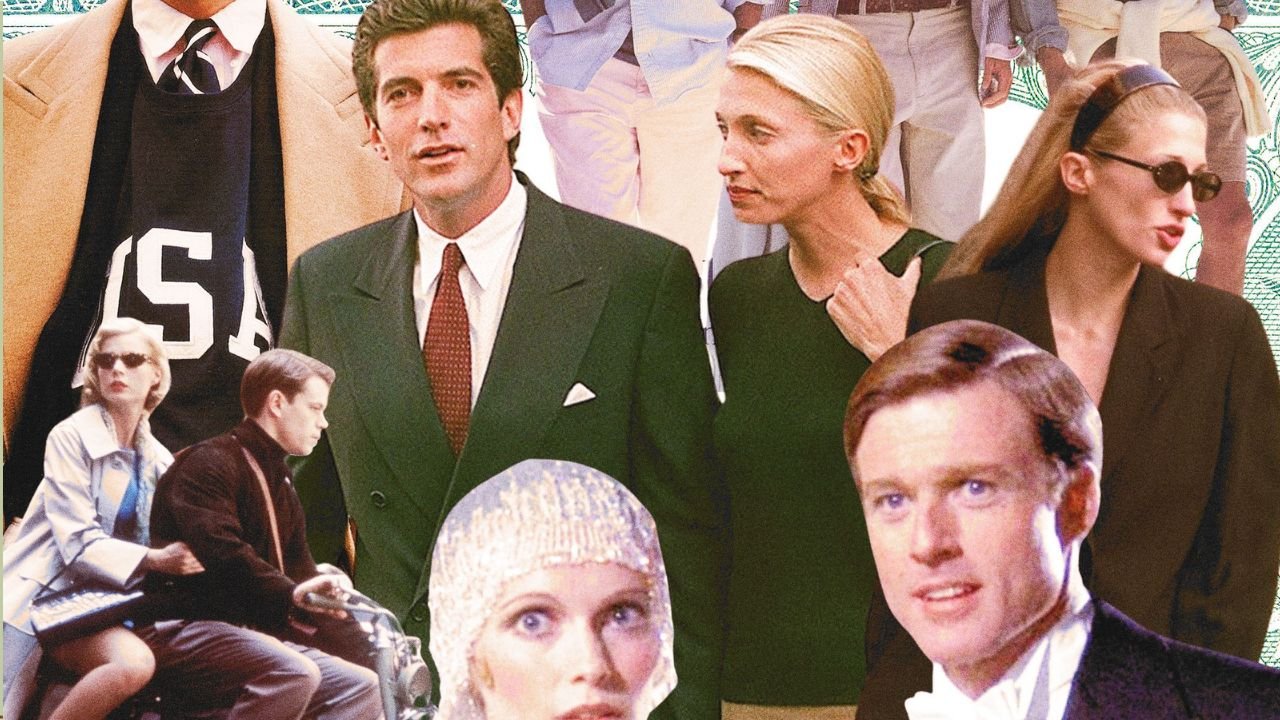The rich never cease to amaze- and this is true when we talk about their taste in clothes. Whether the buttoned-up decorum of the Roy family of Succession or the very casual casualness of the hoodies of Mark Zuckerberg, what the rich wear fascinates the rest of us. However, in the recent past, a tectonic shift has taken place in the sartorial presentation of wealth online, bringing in the new celebrating, emulated, and joked about, look and feel of the so-called old money.
This aesthetic has taken TikTok, Instagram, and Pinterest by storm. Hashtags like #OldMoneyAesthetic and #OldMoneyStyle showcase images of stately fashion—think crisp oxford shirts, pearl accessories, and loafers with just the right amount of wear. It’s Carolyn Bessette-Kennedy walking through Manhattan in a cashmere coat. It’s JFK Jr. on a sailboat in white trousers. It’s Jude Law as Dickie Greenleaf in The Talented Mr. Ripley. And yet, while rooted in mid-20th-century East Coast prep, this trend is being reinterpreted for the digital age.
So, what was once described as an old money aesthetic has come to represent something more than Eurocentric ideals. In this case, it is a fallacy of idealizing the past that has become a cultural phenomenon, as well as a performance of class expressing itself through Gen Z.
What Is the Old Money Aesthetic?
In its essence, the old money aesthetic is a particular type of fashion language, which implies a reserved but not over-the-top expensive style specifics: classic, without any glitz and glamour. It is about an attire that denotes generational wealth rather than new wealth. According to Richard Thompson Ford, author of Dress Codes: How the Laws of Fashion Made History: it is the style of the mid-20th century East Coast elite.
Key Features of the Old Money Aesthetic:
- Timeless Silhouettes: Blazers, pleated trousers, midi skirts, tennis skirts.
- Muted Color Palettes: Navy, beige, cream, forest green, oxblood.
- Luxury Fabrics: Cashmere, wool, cotton poplin, silk.
- Understated Accessories: Pearl earrings, gold watches, tortoiseshell sunglasses.
- Brands Favored: Ralph Lauren, Lacoste, Brooks Brothers, Hermès, Loro Piana.
A Short Overview of Cultural Origins
The aesthetic is descended of the preppy culture of the Ivy League schools which is written about in books such as Take Ivy and the Official Preppy Handbook. Once it was the secret sartorial language of the insider, anchored in legacy, privilege and exclusivity, but now it is grist to the social media mill.
It never concerned trends. Even connotation of old money fashion depended upon things that would be lasting in a fashion sense and even physically. The notion was that you paid well and used that stuff to last decades and maybe hand down.
“Some of the clothing was worn-in, well-worn, that was part of the aesthetic,” says Ford. “Looking worn-in, that patina of age, was part of the appeal.”
This is not just a style—it’s a coded language.
Why Is Gen Z So Obsessed?
There’s an irony to Gen Z, the generation facing skyrocketing student loans and a housing crisis, emulating the fashion of America’s elite. But their embrace of old money style is more layered than simple mimicry.
1. Nostalgia for a “Better Time”
In the chaos of modern life, the old money aesthetic represents order. It evokes an imagined time when things were elegant, slow, and stable—even if that world was only accessible to a privileged few.
“The first thing that comes to mind is nostalgia,” says Ford. “Nostalgia for better times, or a time when the United States and the West seemed more confident.”
2. Post-Pandemic Dressing
After years of athleisure and loungewear, many feel a renewed urge to dress up. It’s not about formality, per se, but intentionality.
“There was this post-COVID thing of dressing up by choice,” says writer and aesthetic aficionado Zach Weiss. “Now there’s this idea of getting dressed up of your own volition.”
3. A Rebellion Against Hyper-Trend Cycles
With microtrends like “cottagecore,” “blokecore,” and “balletcore” coming and going at breakneck speed, the old money aesthetic offers a safe haven—a style that doesn’t demand you reinvent your wardrobe every season.
4. Costume and Character
There’s a performative quality to the aesthetic. For many young people, it’s a way to inhabit a role—a character out of a Nancy Meyers film or an F. Scott Fitzgerald novel.
“This new generation seems really self-aware,” says Weiss. “The old money look is like a character you can play.”
The Role of Pop Culture during the Revival
The media world has succeeded in reviving the outdated fashion of old money in a spectacular manner. The following is cultural touchpoints:
- Saltburn (2023): The dark tale of privilege and seduction tells about wealth enriched with the beautiful imagery of Emerald Fennell.
- Ripley (2024): Netflix takes a beautiful and dangerous view of Patricia Highsmith story in a shiny new version.
- Feud: Capote Vs. the Swans: Ryan Murphy s interpretation of women of elevated society in the mid-twentieth century in New York is a feast on the eyes of the aesthetic.
In the meantime, more streetwear-savvy labels, Aim E Leon Dore, Rowing Blazers, and Drake s are blurring the line with streetwise style, and it turns out old money can even get a makeover and become democratic.
Is the Trend Ironical or Dreamy?
The juxtaposition is that of the attraction toward riches and the criticism against riches. It is not unlike a slide show of linen trousers and sailboats and then a subsequent rant over the state of late-stage capitalism on TikTok.
According to fashion historian Avery Trufelman, the kind of style you dress up in does not imply supporting the upper classes:
“There’s some comfort in dressing as old money,” she says. “Not to be flippant, but it’s not new money like these guys like Elon Musk… who are ruining the world.”
Instead, it’s about creating a personal mythology. Wearing the old money aesthetic allows you to escape into a narrative—whether or not your life resembles it.
Objections and Contratilities
There is a genuine risk of romanticisering the world that was very exclusive in a way. The aesthetic conceals the darker aspects of classes/race/gender privilege. It can be a strong action, though, to many, in particular, those with marginalized backgrounds, to reclaim and recontextualize this style.
“I am shaking it up a bit: says Zach Weiss, a self-proclaimed gay preppy. To him, style does not necessarily need to match with the script.
Last Words: A Cosplay or Way of Life?
Old money aesthetic is not only a visual, but it is a feeling, the desire to have some eternal in this fleeting world. Worn in a tone of irony, or of admiration, or of a measure of both, it is none the less irresistibly alluring.
As Ralph Lauren once said:
“I don’t design clothes. I design dreams.”
And for Gen Z, weary from modern anxieties, the old money aesthetic might just be the dream they want to live in—even if just for a moment on Instagram.
Read More Blogs 🙂



